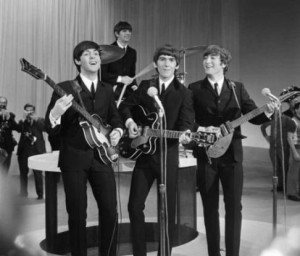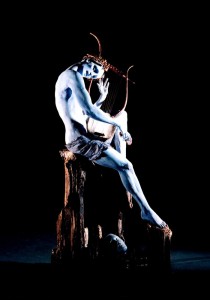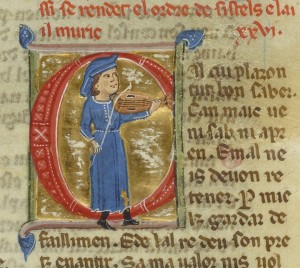Guest post by Arizona Humanities speaker and scholar Dr. Jay Craváth
![SB - Jay Cravath Troubadour[1]](https://azhumanities.org/wp-content/uploads/2014/04/Troubadour1.jpg) What is that singular power a love song unleashes upon the heart? The poignancy of lyric, melody cloaked in a sensuous progression of chords. Fred Astaire sang “The Way You Look Tonight” to Ginger Rogers—winning her love and an Oscar for best song. In 1936, it also pulled a nation into a fantasy of romance and refinement—and away from the bleakness of the Depression. The frenzy Elvis caused by taking blues with those flatted 5th notes and supercharging them was raw power. Then he gyrated his hips in such a provocative way that Ed Sullivan told his cameraman not to video below the waist.
What is that singular power a love song unleashes upon the heart? The poignancy of lyric, melody cloaked in a sensuous progression of chords. Fred Astaire sang “The Way You Look Tonight” to Ginger Rogers—winning her love and an Oscar for best song. In 1936, it also pulled a nation into a fantasy of romance and refinement—and away from the bleakness of the Depression. The frenzy Elvis caused by taking blues with those flatted 5th notes and supercharging them was raw power. Then he gyrated his hips in such a provocative way that Ed Sullivan told his cameraman not to video below the waist.

And of course the Beatles. John Lennon was raised on the hardscrabble sounds of Africa/America. Race music—before its sway and bump-in-the-night lyrics begat the moniker of “rock and roll.” Paul McCartney’s father did weekend gigs in small towns around England, singing the American Songbook. On the group’s first U.S. album—“Meet the Beatles,” is a cover of “Til There was You”—from “the Music Man.” Paul was raised hearing tunes with melodic hooks and complex chords. When they combined forces as songwriters, the result was a new kind of sound—the drive of rock with the sophistication of musical structure. It caught the world by surprise and young girls, listening with quiet hysteria in their rooms, were only able to react with screams when they encountered the Fab Four live.
 Yet the recognition of music’s power to conjure love is as old as the Greek gods. Orpheus, “with his lyre, led the trees, led the wild beasts…” The son of an immortal and a prince of Thrace—Thracians were said to be the most musical of all Greece—captivated all who heard his song. This included the lovely Eurydice, daughter of Apollo. They were married, but when she was bitten by an asp and died, Orpheus began a song so mournful and moving that the deities suggested he try to retrieve his wife from the underworld. Indeed, when the musician reached the throne of Hades and played, the god released Eurydice with the condition that Orpheus not look back as she followed him out through the passage. Alas, he could not keep his eyes to the front and the goddess disappeared back into the depths.
Yet the recognition of music’s power to conjure love is as old as the Greek gods. Orpheus, “with his lyre, led the trees, led the wild beasts…” The son of an immortal and a prince of Thrace—Thracians were said to be the most musical of all Greece—captivated all who heard his song. This included the lovely Eurydice, daughter of Apollo. They were married, but when she was bitten by an asp and died, Orpheus began a song so mournful and moving that the deities suggested he try to retrieve his wife from the underworld. Indeed, when the musician reached the throne of Hades and played, the god released Eurydice with the condition that Orpheus not look back as she followed him out through the passage. Alas, he could not keep his eyes to the front and the goddess disappeared back into the depths.
 Our notion of romantic love began with the Golliards of the Middle Ages. These secular poets wrote of courtly love and troubadours began setting them to music. Love often involved a man and woman separately married. The fulfillment was intended to be spiritual only, with erotic tension the tease. This was not agape (love for humankind), nor eros—“the zeal of the organs for each other” as Joseph Campbell says—but amor. Guiraut de Bronelh, one of the most respected of the troubadours, describes it as born of the eyes and heart:
Our notion of romantic love began with the Golliards of the Middle Ages. These secular poets wrote of courtly love and troubadours began setting them to music. Love often involved a man and woman separately married. The fulfillment was intended to be spiritual only, with erotic tension the tease. This was not agape (love for humankind), nor eros—“the zeal of the organs for each other” as Joseph Campbell says—but amor. Guiraut de Bronelh, one of the most respected of the troubadours, describes it as born of the eyes and heart:
So, through the eyes love attains the heart
For the eyes are the scouts of the heart
And the eyes go searching
For what would please the heart to possess
And when they are in full accord
And firm all three in the one resolve
At that time perfect love is born
 Dr. Craváth discusses this and its Arizona themes in “Romancing Arizona: Songs of Love and Marriage.”
Dr. Craváth discusses this and its Arizona themes in “Romancing Arizona: Songs of Love and Marriage.”
